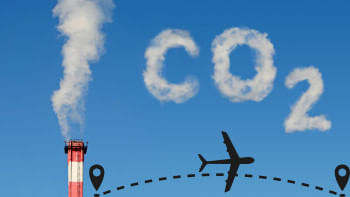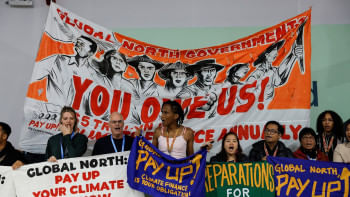Energy transition can address global energy inequality

It is well-established that the world is deep into the climate crisis, posing multi-dimensional hazards, risks, vulnerabilities, and loss and damage. Multiple studies indicate that climate-related damages have increased by five to seven percent in the last 10 years, resulting in an economic loss amounting to around $270 billion in 2023 alone, while in 2022, the loss and damage costs reached $1.5 trillion. This, unfortunately, is just the beginning. The Intergovernmental Panel on Climate Change (IPCC) introduced the concept of climate system tipping point more than two decades ago, and various studies now confirm that many of those tipping points could be exceeded much sooner than anticipated.
We are currently at 1.2 degrees Celsius above the pre-industrial period, and the Paris Agreement benchmark is 1.5 degrees Celsius. The year 2023 is the warmest year on record, but what has gone less noticed is that the average temperature between February 2023 and January 2024 was 1.52 degrees Celsius above the pre-industrial period, exceeding the Paris Agreement threshold by 0.02 degrees Celsius, according to the Copernicus Climate Change Service. Whether this shift is temporary or lasting, it is clear that our mitigation strategies and actions have proven inadequate. Bangladesh alone faced five major climatic shocks only in 2024, with a month yet to go.
Since 1750, humankind has doubled atmospheric carbon, adding 210 parts per million (ppm) of CO2. In just the last 22 years, an additional one quarter of that doubled carbon has been added, leaving us with 422 ppm of carbon in the atmosphere today. Development and energy consumption are strongly correlated, and developed countries grew rich by emitting 92 percent of excess carbon by burning fossil fuels. On a national scale, the US alone, through its 22 mega fossil fuel projects, emits a fifth of the global carbon emission.
On an individual level, the richest 10 percent of people globally emit as much as 50 percent of carbon, while the wealthiest one percent emits double the carbon that the poorest 50 percent of the world's population emits combined. Moreover, the emissions of a single billionaire (three million tonnes) are a million times higher than the emissions of an individual (2.76 tonnes) in the bottom 90 percent of humanity. In stark contrast, the entire African continent emits less than four percent, and developing countries like Bangladesh emit less than 0.5 percent.
As the Global North and the wealthiest continue these egregious practices, global leaders like the COP28 president dismiss the science behind the 1.5-degree-Celsius threshold with calls for a fossil fuel phaseout. The world is edging closer to what UN Secretary-General António Guterres has termed "global boiling." Yet, emissions continue to rise, and an additional 16 percent increase by 2030 will push us to 2.7 degrees Celsius by 2100. To limit global warming to 1.5 degrees Celsius, we must halve the emission by 2030, and reach net zero by 2050, which eventually might prevent us from irreversible climate emergency. Ironically, despite having already surpassed 1.5 degrees Celsius and reached multiple tipping points, 82 percent of the world's energy still comes from fossil fuels, while only 6.5 percent comes from renewable sources.
There is, however, immense potential for renewables as the Earth receives about 1.52 million TWh of energy annually only from solar, which is 8,700 times more than the annual global energy demands (170,000 TWh). Additionally, there are other renewable sources feasible enough based on the geographic locations.
Energy transition is considered one of the most plausible solutions to save humanity from the brunt of climate change. If we consider the fair share of carbon, the Global North has already exceeded its limit. And yet, if they continue using fossil fuels while prescribing transitions for developing nations, it becomes an unjust, colonial approach. More importantly, we must assess the entire life cycle of the energy transition and ensure it does not place an additional burden on developing nations in terms of finance, environmental degradation through resource extraction, loss of natural resource rights for marginalised communities, job loss, etc.
The ideal recommendation is Just Energy Transition (JET). Least developed countries (LDCs) can phase out coal, then developing nations should immediately phase out fossil fuels. The Global North and wealthy nations should finance the energy transition for LDCs, and developing countries should transfer renewable energy technologies to them. Moreover, the JET must be rooted in four pillars of justice: a) historical injustices, rights, and concerns of marginalised and impacted communities must be recognised; b) affected people, associations, and civil society voices must be reflected in policies and all energy transition processes; c) responsibilities and benefits of the transition must be equitably distributed; and d) affected people must be fairly compensated for energy transition-related harm and loss and damage as part of the remedy.
The world is a shared space, and as we tackle the common climate crisis, we must do so with equity at the forefront, not vested interests. This is the way to introduce JET—the key to an equal and sustainable future.
Dr Mohammad Emran Hasan is head of climate justice and natural resources rights at Oxfam in Bangladesh. He can be reached at [email protected].
Views expressed in this article are the author's own.
Follow The Daily Star Opinion on Facebook for the latest opinions, commentaries and analyses by experts and professionals. To contribute your article or letter to The Daily Star Opinion, see our guidelines for submission.


 For all latest news, follow The Daily Star's Google News channel.
For all latest news, follow The Daily Star's Google News channel. 









Comments